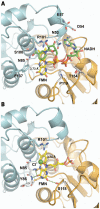Structure determination and functional analysis of a chromate reductase from Gluconacetobacter hansenii
- PMID: 22879982
- PMCID: PMC3412864
- DOI: 10.1371/journal.pone.0042432
Structure determination and functional analysis of a chromate reductase from Gluconacetobacter hansenii
Abstract
Environmental protection through biological mechanisms that aid in the reductive immobilization of toxic metals (e.g., chromate and uranyl) has been identified to involve specific NADH-dependent flavoproteins that promote cell viability. To understand the enzyme mechanisms responsible for metal reduction, the enzyme kinetics of a putative chromate reductase from Gluconacetobacter hansenii (Gh-ChrR) was measured and the crystal structure of the protein determined at 2.25 Å resolution. Gh-ChrR catalyzes the NADH-dependent reduction of chromate, ferricyanide, and uranyl anions under aerobic conditions. Kinetic measurements indicate that NADH acts as a substrate inhibitor; catalysis requires chromate binding prior to NADH association. The crystal structure of Gh-ChrR shows the protein is a homotetramer with one bound flavin mononucleotide (FMN) per subunit. A bound anion is visualized proximal to the FMN at the interface between adjacent subunits within a cationic pocket, which is positioned at an optimal distance for hydride transfer. Site-directed substitutions of residues proposed to involve in both NADH and metal anion binding (N85A or R101A) result in 90-95% reductions in enzyme efficiencies for NADH-dependent chromate reduction. In comparison site-directed substitution of a residue (S118A) participating in the coordination of FMN in the active site results in only modest (50%) reductions in catalytic efficiencies, consistent with the presence of a multitude of side chains that position the FMN in the active site. The proposed proximity relationships between metal anion binding site and enzyme cofactors is discussed in terms of rational design principles for the use of enzymes in chromate and uranyl bioremediation.
Conflict of interest statement
Figures




Similar articles
-
Insights into the mode of flavin mononucleotide binding and catalytic mechanism of bacterial chromate reductases: A molecular dynamics simulation study.J Cell Biochem. 2019 Oct;120(10):16990-17005. doi: 10.1002/jcb.28960. Epub 2019 May 26. J Cell Biochem. 2019. PMID: 31131470
-
The structural and functional basis of catalysis mediated by NAD(P)H:acceptor Oxidoreductase (FerB) of Paracoccus denitrificans.PLoS One. 2014 May 9;9(5):e96262. doi: 10.1371/journal.pone.0096262. eCollection 2014. PLoS One. 2014. PMID: 24817153 Free PMC article.
-
Arginine-95 is important for recruiting superoxide to the active site of the FerB flavoenzyme of Paracoccus denitrificans.FEBS Lett. 2019 Apr;593(7):697-702. doi: 10.1002/1873-3468.13359. Epub 2019 Mar 23. FEBS Lett. 2019. PMID: 30883730
-
Chromate-reducing properties of soluble flavoproteins from Pseudomonas putida and Escherichia coli.Appl Environ Microbiol. 2004 Feb;70(2):873-82. doi: 10.1128/AEM.70.2.873-882.2004. Appl Environ Microbiol. 2004. PMID: 14766567 Free PMC article.
-
Structure analysis of the flavoredoxin from Desulfovibrio vulgaris Miyazaki F reveals key residues that discriminate the functions and properties of the flavin reductase family.FEBS J. 2009 Sep;276(17):4840-53. doi: 10.1111/j.1742-4658.2009.07184.x. FEBS J. 2009. PMID: 19708087
Cited by
-
Global transcriptome analysis of hexavalent chromium stress responses in Staphylococcus aureus LZ-01.Ecotoxicology. 2014 Oct;23(8):1534-45. doi: 10.1007/s10646-014-1294-7. Epub 2014 Aug 3. Ecotoxicology. 2014. PMID: 25086489
-
Phenotypic and resistome analysis of antibiotic and heavy metal resistance in the Antarctic bacterium Pseudomonas sp. AU10.Braz J Microbiol. 2023 Dec;54(4):2903-2913. doi: 10.1007/s42770-023-01135-7. Epub 2023 Oct 2. Braz J Microbiol. 2023. PMID: 37783937 Free PMC article.
-
Chemical-Assisted Microbially Mediated Chromium (Cr) (VI) Reduction Under the Influence of Various Electron Donors, Redox Mediators, and Other Additives: An Outlook on Enhanced Cr(VI) Removal.Front Microbiol. 2021 Jan 28;11:619766. doi: 10.3389/fmicb.2020.619766. eCollection 2020. Front Microbiol. 2021. PMID: 33584585 Free PMC article. Review.
-
Cloning and sequence analysis demonstrate the chromate reduction ability of a novel chromate reductase gene from Serratia sp.Exp Ther Med. 2015 Mar;9(3):795-800. doi: 10.3892/etm.2014.2148. Epub 2014 Dec 18. Exp Ther Med. 2015. PMID: 25667630 Free PMC article.
-
Dying for Good: Virus-Bacterium Biofilm Co-evolution Enhances Environmental Fitness.Biochem Insights. 2012 Jul 3;5:1-9. doi: 10.4137/BCI.S9553. eCollection 2012. Biochem Insights. 2012. PMID: 25114551 Free PMC article.
References
-
- Wall JD, Krumholz LR (2006) Uranium reduction. Annu Rev Microbiol 60: 149–166. - PubMed
-
- Fredrickson JK, Zachara JM (2008) Electron transfer at the microbe-mineral interface: a grand challenge in biogeochemistry. Geobiology 6: 245–253. - PubMed
-
- Lovley DR, Phillips EJP (2002) Bioremediation of uranium contamination with enzymatic uranium reduction. Environmental Science & Technology 26: 2228–2234.
-
- Reguera G, McCarthy KD, Mehta T, Nicoll JS, Tuominen MT, et al. (2005) Extracellular electron transfer via microbial nanowires. Nature 435: 1098–1101. - PubMed
Publication types
MeSH terms
Substances
Grants and funding
LinkOut - more resources
Full Text Sources

